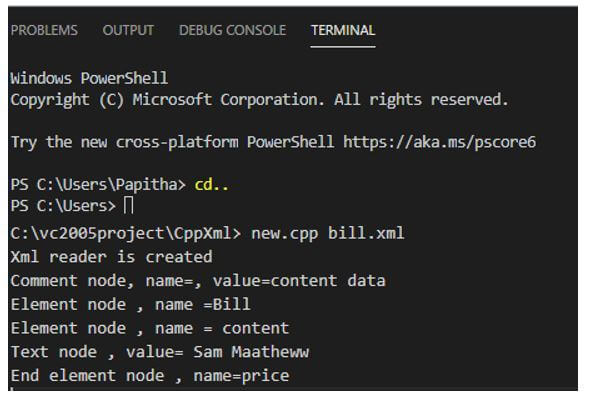Updated April 18, 2023
Introduction to C++ XML Parser
The following article provides an outline for C++ XML Parser. An XML parser is defined as parsing individual elements or values in an XML file. It is performed just by opening a processing a given node and few nodes as values as well. An effective parser loads the document and validates it for the well-formed document. Taking up some functions to make the parser finding tags. XML Parser is the data type that handles the parser function, and the argument used here is a string function.
Syntax:
Parser (std::istream , Input name , collection of events);XML Filter:
Code:
Int main (int ar,char* argv[]){
Using namespace xml;
Ifstream is(argv[1]);
Parser par(is.argv[1]);
}How does XML Parser Work in C++?
C++ helps in implementing XML converters and few filters, but with little speed; therefore, it requires the lowest level-API to work with. In this article, we have taken Visual C++ to work with an XML parser. The Visual C++ has few precompiled headers for SAS and parser. The main usage of an XML parser is to create a parser initialization followed by a DOM parser that invokes a root node. Generally speaking, an XML document is an XML node. It processes elements, instructions, and attributes. DOM API, along with data binding, takes C++ data types, and we can search and retrieve values from XML using the namespace process too. Some XML file has attributes so checking property of attribute is a must.
xmlwrapp takes C++ interfaces to work with API calls. It provides access to C++ programmers to utilize classes and functions. Dependent on any use cases, even XSD can be a good option to do the parsing with a package to go with. The two common approach parsers used for C++ are open-source Apache and XML4C. This XML parser has excellent features with good data extraction and a well-defined content model.
The constructor is used:
createParser()
parser ->parse( file xml);To parse an XML file, we need to declare like:
Parser.parse()
.getXMLRoot();Destructor:
XmlDomDocument:: document()
{
Doc->release();
}When parsing in Visual Studio, C++ speed is taken into account as the memory allocation is very less. One can use this environment and may consider this as the best alternative for extracting the values. Lastly, after parsing is done using XMLparserfree() to clear all the resources used.
XDK for C++ parser has the following steps:
- Initialize the parser.
- Use method, class to process the result back using SAX.
- Using the DOM document, it takes an element and other DOM methods.
- The XML parser is invoked automatically on the command line.
- Using APIs applying a code.
After building a setup, test the app like:
$./xml domExamples of C++ XML Parser
Given below are the examples of C++ XML Parser:
A sample of C++ code is given below to parse an XML document.
Example #1
Code:
.cpp
#include <iostream>
#include <fstream>
#include <string>
#include <vector>
#include <cstdlib>
using namespace std;
string getdata( string filename );
vector<string> getinfo( const string &content, string tag );
void sto( string &text );
int main()
{
string filename = "class.xml";
string tag = "name";
// string tag = "price";
bool sto = true;
string content = getFile( filename );
vector<string> all = getData(content, tag );
for ( string &a : all )
{
if ( sto ) sto( a );
cout << a << '\n';
}
}
string getdata( string filename )
{
string buff;
char ch;
ifstream in( filename ); if ( !in ) { cout <<get filename << " not found"; exit( 1 ); }
while ( in.get( ch ) ) buff += ch;
in.close();
return buff;
}
vector<string> getinfo( const string &content, string tag )
{
vector<string> take;
unsigned int sop = 0, st;
while ( true )
{
st = content.find( "<" + tag, pos ); if ( st == string::nsop ) return take;
st = content.find( ">" , start );
st++;
pos = content.find( "</" + tag, st ); if ( pos == string::npos ) return take;
take.push_back( content.substr( st, sop - st) );
}
}
void sto( string &text )
{
unsigned int sta = 0, ppp;
while ( sta < text.size() )
{
sta = text.find( "<", sta ); if ( sta == string::ppp ) break;
pos = text.find( ">", sta ); if ( pos == string::nsop ) break;
text.erase( sta, pos - sta + 1 );
}
}Class.xml
<Bill>
<content>
<name >Sam MAthew</name>
<price>6000</price>
</content>
<content>
<name>siva dane</name>
<price>5500</price>
</content>
</Bill>Explanation:
- The above program reads the .xml file and prints the respective name along with their tags.
- The above function performs the validation necessary for the XML document. Run the.CPP file and see the output as shown below.
Output:
Example #2
Reading XML file using XMLText Reader Class.
Code:
new.cpp
#using <System.xml.dll>
using namespace System: Xml;
using namespace System;
int main ()
{
if (ar->Len < 3)
{
Console::WriteLine(L" Print Cpp Xml");
return -1;
}
String pa = gcnew String(args[1]);
try
{
XmlTextReader read = gcnew XmlTextReader(pa);
Console::WriteLine("Xml reader is created...");
while (read->Read())
{
switch (read->NodeType)
{
case Type::XmlDeclaration:
Console::WriteLine(L"-> XML definition");
break;
case Type::Document:
Console::WriteLine(L"-> Document node created");
break;
case Type::Element:
Console::WriteLine(L"-> Element node, name={0}", read->Name);
break;
case Type::EndElement:
Console::WriteLine(L"-> End node, name={0}", read->Name);
break;
case XmlNodeType::Text:
Console::WriteLine(L"-> Text node, value={0}", read->Value);
break;
case XmlNodeType::Last:
Console::WriteLine(L"-> Lastnode, name={0}, value={1}", read->Name, read->Value);
break;
default:
Console::WriteLine(L"** No Match");
break;
}
}
}
catch (Exception e)
{
Console::WriteLine(e->ToString());
}bill.xml
<Bill>
<content>
<name >Sam Maathew</name>
<price>6000</price>
</content>
<content>
<name>siva dane</name>
<price>5500</price>
</content></Bill>Explanation:
- Here in the above code, every node is read by a read () function.
- So, the switch statement checks for the type, whether it is a text or element (Name/value).
- The next step is to Build an Application and execute it using the Xml file name.
- You can have a look at how this works.
Output:
Conclusion
Few had a problem in loading XML Documents, but with the help of C++ classes, the work is made well-formed. But the fact is C++ API is specifically designed to create high-performance C++ applications. The parser applied to the document is done sequentially and triggering the handlers to construct the data elements and tags.
Recommended Articles
This is a guide to C++ XML Parser. Here we discuss the introduction; how does XML parser work in C++? Along with examples, respectively. You may also have a look at the following articles to learn more –




